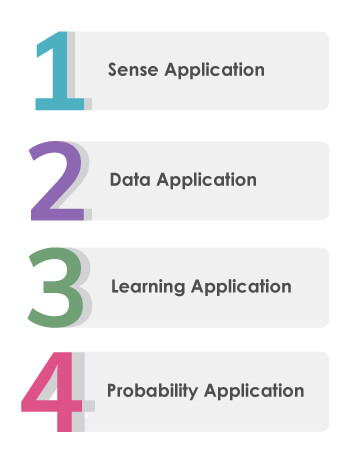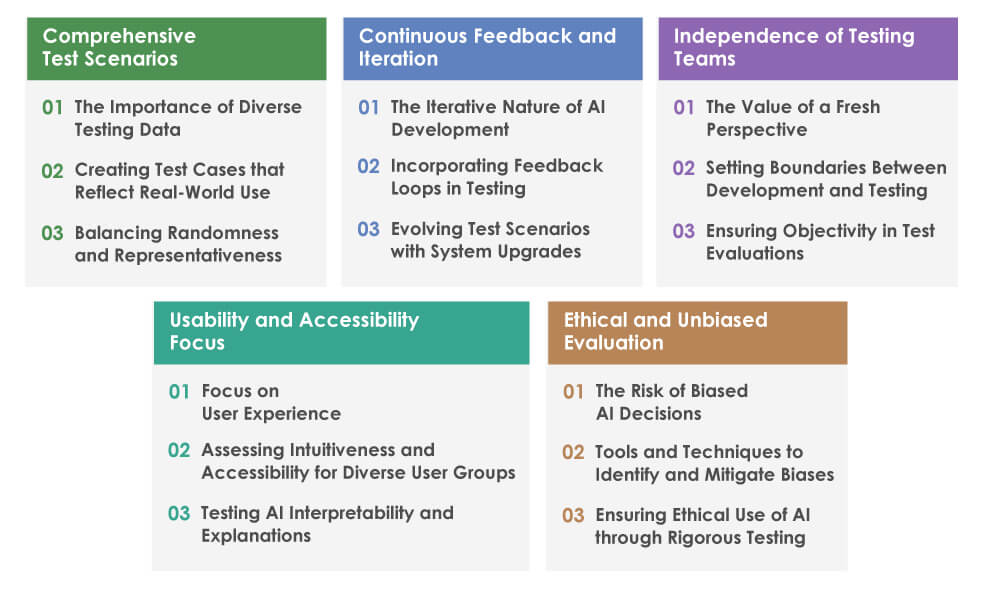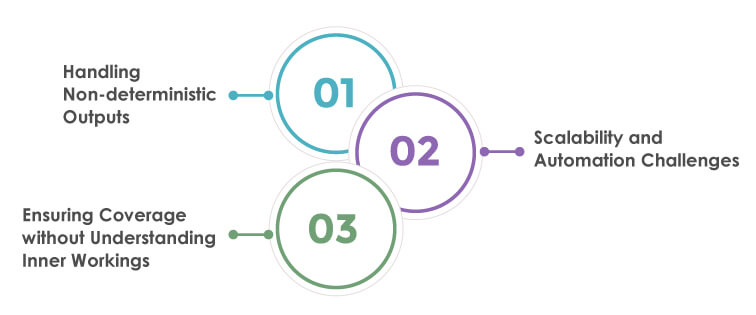Published: 28 Sep 2023
5 Key Black Box Testing Principles for AI Systems
According to a study, 35% of businesses have already integrated AI into their operations, while an additional 42% are actively researching its potential for future implementation. Yet, despite this surge in AI adoption, many do not know about the inner processes of these systems, leading to potential pitfalls in reliability and performance. But how can companies ensure their AI systems are dependable and free from bugs when the inner workings are inaccessible? That is where black-box testing for AI comes in.
Understanding Black Box Testing

Black Box Testing examines how a system responds to inputs without delving into internal mechanisms. Imagine giving a sealed puzzle box a shake; the user will be more interested in its sound than the hidden pieces. QA engineers assess software based on its functionality and observable behaviours in this approach. They don’t need to know the underlying code or structures. By concentrating on outputs and user experience, Black Box Testing ensures that software meets users’ needs and expectations while the complexities of its design and operation remain undisclosed.
Why Black Box Testing is Essential for AI Systems
In a traditional software system, expectations are clear. There’s a defined input and a predicted output. However, AI systems present a new challenge with their learning capabilities and dynamic behaviours. AI is shaping our future, from healthcare diagnostics to autonomous vehicles. Given the stakes, it’s no surprise that ensuring these systems perform reliably is necessary. Black Box Testing offers an unbiased, objective mechanism to evaluate AI system performance. It isolates performance from the complexities and potential biases embedded deep within algorithms.
4 Black Box Testing Techniques for AI

Sense Application
This involves simulating AI logic outcomes over a specific timeframe and comparing them with real-world results. Doing this shows how the AI performs in real-world situations. Fine-tune the control variables and improve the results to pinpoint any inconsistencies. This method, often called Posterior Predictive Checks (PPC), entails simulating and contrasting data based on a model with observed data. Testers use posterior predictive checks to identify marked differences between genuine and simulated data.
Data Application
Think about testing as a rocket launch. Every control is tested against various parameters, such as weather, temperature, and pressure. Even a slight gust of wind can cause deviations. Similarly, ensuring that all potential variables are accounted for is crucial when trying AI logic. Choosing the optimal test data, which offers the most comprehensive coverage, will deliver superior results.
Learning Application
Before starting with black box testing, it’s essential to understand the functionalities under evaluation. The more in-depth data on these functionalities, the more effective test cases will be. This principle applies to AI logic too. Neural Networks, inspired by human brain functions, can learn AI logic, which in turn helps generate test cases. Experts train this neural network using test cases from the original AI platform, focusing only on the system’s inputs and outputs. Once trained, this network can evaluate the accuracy of output produced by AI.
Probability Application
While AI models often operate on a large scale, their “common sense” comes from accurate testing and training. It’s essential to pinpoint those regression test cases that thoroughly cover the AI’s abstraction. Fuzzy Logic approaches prove beneficial here, classifying which test cases to retest based on their likelihood of accuracy. This maximises regression testing coverage, ultimately enhancing the AI solution’s performance in real-world scenarios.
But why is Black Box Testing so crucial for AI?
Firstly, AI is dynamic. A report by Deloitte highlighted that nearly 32% of AI implementations experienced unexpected decision-making shifts in their first year, highlighting the need for rigorous testing.
Secondly, some people harnessing AI are AI specialists. The complex neural networks and deep learning models are as understandable for most users as a foreign language. They’re seeking results, not an algorithmic explanation. Black Box Testing, thus, ensures these users can trust the system’s outputs without drowning in the details.
Lastly, the AI market is booming. According to a report, it’s predicted to reach $190 billion by 2025. This surging demand compels a rapid-to-market approach. With its straightforward process, Black Box Testing helps businesses confidently deploy AI systems, assuring their clients of quality and reliability.
Black Box Testing Principles for AI Systems
The importance of rigorous testing must be balanced to make AI systems reliable, secure, and functional. Black Box Testing, a critical approach, offers insights into the functionality and reliability of these systems without delving into their complex internal mechanisms. Let’s look into five fundamental principles that facilitate effective Black Box Testing for AI systems, ensuring their robustness, ethical integrity, and usability.

Comprehensive Test Scenarios
The Importance of Diverse Testing Data
An AI is only as versatile as the data it trains on. By feeding diverse testing data, AI can perform confidently across multiple industries. A well-rounded AI system, refined through comprehensive Black Box Testing, often becomes a market differentiator.
Creating Test Cases that Reflect Real-World Use
AI operates in the real world. Hence, our test cases must mirror real-life scenarios. Businesses can confidently deploy solutions that resonate with users’ needs by ensuring our AI systems have been through life-like tests.
Balancing Randomness and Representativeness
It’s a delicate dance. While randomness uncovers unforeseen issues, representativeness ensures AI’s readiness for typical scenarios. A robust Black Box Testing strategy masterfully balances both, setting AI systems up for the expected and the unexpected.
Continuous Feedback and Iteration
The Iterative Nature of AI Development
AI development isn’t linear; it’s cyclical. It learns, adapts, and evolves. Recognising this fluidity, Black Box Testing should embrace an iterative approach, mirroring the dynamic progression of AI systems.
Incorporating Feedback Loops in Testing
By integrating continuous feedback loops in Black Box Testing, AI systems can refine themselves, allowing businesses to stay ahead of the competition and meet user expectations.
Evolving Test Scenarios with System Upgrades
As AI systems undergo upgrades, so must the test scenarios. This evolution guarantees that the AI, irrespective of its version or upgrade status, remains consistently dependable.
Independence of Testing Teams
The Value of a Fresh Perspective
A QA tester view often spots what developers might miss regardless of the development process. An independent Black Box Testing team brings this invaluable perspective, ensuring a comprehensive evaluation.
Setting Boundaries Between Development and Testing
By clearly distinguishing the development and testing processes, businesses can uphold the integrity and objectivity of Black Box Testing, delivering AI solutions that genuinely stand the test of time and scrutiny.
Ensuring Objectivity in Test Evaluations
Testing teams should operate independently of the development team to maintain this objectivity. It guarantees unbiased evaluations, ensuring AI systems are built right and built to excel.
Usability and Accessibility Focus
Focus On User Experience
Focusing on UX within Black Box Testing ensures that AI doesn’t just operate – it satisfies users, setting brands distinctly apart in the competitive marketplace.
Assessing Intuitiveness and Accessibility for Diverse User Groups
AI must cater to everyone in an inclusive world. Black Box Testing emphasises accessibility, ensuring AI systems fit well with everyone, from tech enthusiasts to complete novices.
Testing AI Interpretability and Explanations
Testing for AI’s ability to offer clear interpretations ensures users trust and understand their AI companions, bridging the human-AI divide.
Ethical and Unbiased Evaluation
The Risk of Biased AI Decisions
Black Box Testing proactively identifies and rectifies biases, safeguarding brand reputation and ensuring AI’s equitable treatment of all users.
Tools and Techniques to Identify and Mitigate Biases
Black Box Testing employs sophisticated techniques to analyse and address biases, ensuring AI deployments remain fair and representative.
Ensuring Ethical Use of AI through Rigorous Testing
Through rigorous Black Box Testing, businesses can ensure that their AI solutions uphold the highest ethical standards like safety, security, robustness, transparency, explainability, etc.
Common Challenges in Black Box Testing for AI
There are some challenges to deal with when it comes to checking how well Artificial Intelligence (AI) systems perform. Let’s talk about three of these issues and figure out how to handle them.

Handling Non-deterministic Outputs
AI systems often produce non-deterministic outputs due to their ability to learn and adapt from vast datasets. This unpredictability poses a challenge in Black Box Testing, which aims to ascertain consistent outcomes. The solution is probabilistic approaches that handle uncertainty. It gauges the AI’s performance across varying results by designing test scenarios incorporating various possible outputs. This probabilistic nature of AI outputs enhances testing accuracy and mirrors these systems’ real-world complexity.
Scalability and Automation Challenges
The scale at which AI systems operate often surpasses manual testing capabilities. This calls for scalable and automated testing
processes. However, automating Black Box Testing for AI isn’t simple. These systems process vast amounts of data and execute complex algorithms, making test automation non-trivial. A comprehensive strategy involving unit testing, integration testing, and end-to-end testing is essential to address this. Automating the testing process while accounting for the complexity of AI operations ensures thorough coverage and frees up valuable human resources for higher-level analyses.
Ensuring Coverage without Understanding Inner Workings
Black Box Testing aims to assess a system’s functionality without delving into its inner workings. However, this raises the challenge of ensuring thorough coverage of the system’s capabilities. How can we test what we don’t entirely understand? The key is to adopt a scenario-driven testing approach. By creating diverse test scenarios exploring different facets of the AI’s behaviour, QA engineers ensure the system is rigorously evaluated. Collaborative efforts between AI experts and testing professionals play a pivotal role here, where domain knowledge confirms the creation of scenarios that push AI to its limits.
Conclusion
Black Box Testing offers a transparent approach through which businesses can understand, evaluate, and refine AI systems. By assessing the AI’s inputs, outputs, and responses, they can uncover vulnerabilities, ensure ethical compliance, and validate the system’s adaptability. This testing methodology is not just about ticking boxes; it’s about instilling confidence in AI systems that drive innovation, enhance efficiency, and augment human capabilities.
How Can TestingXperts Help with AI Testing?
TestingXperts, a leading QA company in software testing solutions, brings its expertise and innovation to AI Testing. Our commitment to excellence, coupled with a deep understanding of AI complexities, sets us apart as your trusted partner in navigating the challenges of AI testing.

Key Differentiators
Expertise in AI Testing
With a dedicated team of experienced professionals well-versed in AI technologies and testing methodologies, TestingXperts brings deep knowledge to every testing project. Our specialists understand the processes of AI systems, enabling them to design targeted testing strategies that uncover vulnerabilities and ensure optimal performance.
Comprehensive Black Box Testing
By examining AI systems from the outside, we assess their functionality, performance, and security without knowing the complicated internal workings. This approach ensures unbiased evaluations and robust validations of your AI’s outputs.
Complete Test Coverage
At TestingXperts, we believe in a holistic testing approach. We go beyond the technical aspects to consider usability, accessibility, and ethical considerations. This comprehensive perspective ensures that your AI systems function flawlessly and align with industry standards and ethical guidelines.
Scalable Solutions
As AI applications scale, so does the complexity of testing. TestingXperts offers scalable testing solutions that adapt to your AI’s growth. Whether it’s handling large datasets, complex algorithms, or dynamic learning systems, our testing solutions keep pace with your AI’s evolution.
Ethical AI Evaluation
Ethical concerns in AI are critical. Our testing methodologies encompass ethical UK regulations, ensuring your AI systems remain unbiased and fair across diverse user groups. We test AI outputs for potential ethical errors, contributing to the creation of AI that respects user diversity and societal norms.
Tailored Testing Strategies
Our testing strategies are tailored to your specific requirements. Whether it’s financial AI, healthcare AI, or any other domain, TestingXperts AI testing processes will align with your industry, technology stack, and business goals.
To know more about AI testing strategies, contact our experts now.